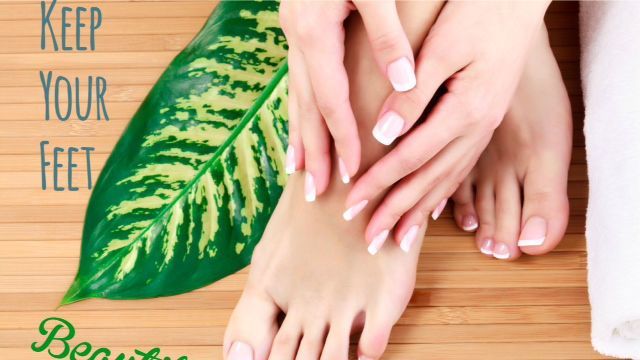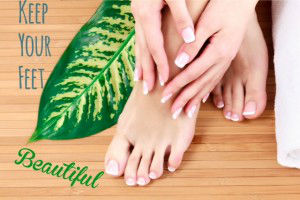
Okay, we admit that fungus, more specifically toenail fungus, is not exactly an appealing topic of conversation. Nor is it a condition that many want to openly admit they struggle with. However, it is a real and common condition that can be both painful and unsightly.
Not only is toenail fungus chronic, it is also potentially contagious. Yep, if your partner has toenail fungus you will not want to share shoes, nail clippers or socks, or freely give out foot rubs until the condition is in order! Toenail fungus can easily spread to the fingernails as well – a place where it is much harder to hide.
What is fungus?
There are several types of fungus that affect the nails, with the most common being Onychomycosis – which has four different sub-types. Nail fungus starts out as a small white, yellow or green spot near the edge of the nail. As the infection spreads deeper below the nail, other symptoms appear. Eventually, the fungus will spread to impact the entire nail and nail bed, which damages any new nail growth, as well.
Onychomycosis may be caused by candida or dermatophytic types of mold. Many people who develop nail fungus contract it from contaminated pedicure equipment. If equipment is not disinfected properly, fungus can spread like wildfire. Some people who have poor circulation in their arms and legs, such as diabetics, are prone to developing fungus.
Those who have a compromised immune system or are suffering from cancer, auto immune disorder or have had an organ transplant are also prone to fungus. If you have ever taken a long course of antibiotics you may also develop fungus, as the antibiotic kills off all the beneficial bacteria that keep the bad bacteria in check.
Do I have fungus?
There are a number of things that you can look for to assess whether or not you may have nail fungus, including:
- Discoloration under the nail, near the edge – usually green, yellow or white
- Tender or sore nails
- Nails that are unusually thick
- Yellow, green or black discoloration
- Nails that crumble around the edges
- Stinky nails
- Distorted nail shape
- Redness or swelling in and around the nail
- Nails that separate from the nail bed
- Rough nail texture
Healthy gut bacteria and toenail fungus
Maintaining healthy gut flora is essential for optimal immune system and brain function. The insult of eating too many denatured foods has taken its toll on our bodies, which need a constant source of good bacteria to keep conditions such as fungus at bay.
Although it may take some time to acquire a taste for fermented foods, eating them is a great way to maintain healthy gut flora. Fermented foods are an excellent source of natural probiotics. A wide range of foods, from dairy to vegetables, can easily be fermented at home.
Beneficial bacteria
The most common beneficial bacteria are the Lactobacillus bacteria, more specifically L. acidophilus. These healthy bacteria exist in our digestive tracts and also in dairy, fruit and vegetables. In the intestines, the bacteria produce lactic acid, which helps promote healthy acidity that keeps bad bacteria from growing.
Lactic acid also encourages the absorption of proteins and minerals including, copper, iron, magnesium, manganese and calcium. Lactobacillus bacteria are responsible for fermentation and inhibit the action of bacteria that cause the food to spoil.
These bacteria increase during the fermentation process and also enhance the enzyme content of food. Fermentation also increases the vitamin B, C and K levels in food while deactivating undesirable nutrients such as phytic acid and protein inhibitors.
Natural antibiotics
Some strains of L. acidophilus even have natural antibiotic and cancer fighting properties, while other strains have been shown to be effective against a variety of viral infections including HIV, herpes and polio. These strains also produce hydrogen peroxide, which can kill undesirable toenail fungus-promoting yeast. Lactobacillus acidophilus strains also fight against such infectious bacteria as Streptococcus and Salmonella.
How much is enough?
Adding just a spoonful of fermented foods to your daily diet provides trillions of beneficial bacteria, which can go to work to improve the strength of your immune system and improve your overall health.
I have fungus – now what?
If you find yourself with an awful case of toenail fungus, there are a number of ways to naturally halt it in its tracks – especially if you catch it early enough before it impacts the entire nail bed.
Once the nail bed is compromised, treatment must continue while a new nail grows out, and this can take up to a year for some people.The one reason why most treatments fail is because people do not continue them consistently for long enough.
Conventional treatments such as anti-fungal medications are available in pill form, or topically and are painted on nails or applied as cream or ointment. Laser treatments are also a popular option, and have been proven effective at treating infections by killing the fungi with heat. Podiatrists may also surgically remove an infected nail or nail piece.
There are, however, a number of natural toenail fungus remedies that are supported by both anecdotal and scientific evidence. Here are five to consider:
Thyme oil: Thyme has been used it medicinally for thousands of years. It has antimicrobial and antioxidant activity that has made it a popular choice for skin infections, as well as fungal nail infections. Apply some oil to the infected area twice daily until the infection goes away.
Apple cider vinegar (ACV): ACV contains potent antifungal, antibacterial and antiviral properties, which help to make it so effective for so many conditions. It can be used to help with nail fungus in two ways; you can drink 2 tablespoons of ACV mixed in 8 ounces of water 3 times daily to help balance pH, and also massage a mixture of 2 tablespoons of ACV and 1 tablespoon of water into your nail 3 times a day.
Tea tree oil: Tea tree (Melaleuca alternifolia) oil can be used on any number of skin conditions. It is one essential oil that you definitely want in your medicine cabinet. Loaded with antiviral, antiseptic and antimicrobial properties, this oil can be applied directly to the skin or mixed with a carrier oil such as sweet almond or grapeseed.
Use this potent essential oil to treat bug bites, cuts, scrapes, ringworm, thrush, nail fungus, athlete’s foot and cold sores. In one study, a cream containing tea tree oil was used to treat toenail fungus, and the results demonstrated its effectiveness when 80 percent of the cases treated were cured of the fungus compared to none in the control group.
Snakeroot leaf extract: Research conducted at the Biomedical Laboratory of the Instituto Mexicano del Seguro Social have found snakeroot leaf extract to be as effective for toenail fungus as some prescription medications when applied topically to affected area.
The study involved 96 subjects; 49 were treated with an active compound form of snakeroot leaf extract and 47 were given 8 percent ciclopirox topical (a common conventional treatment). The results demonstrated that natural nail treatment can be equally as effective as harsh chemicals in destroying fungus.
 Other tips
Other tips
Use these tips to keep your feet and nails as healthy as possible and prevent fungus from developing:
- Visit a nail salon that disinfects all metal equipment or uses disposables.
- Keep your hands and feet dry.
- Wear loose shoes that have an open toe frequently.
- If you think you have an infection, don’t wait to administer treatment.
- Eat a balanced diet with plenty of fresh fruits, vegetables and healthy fats.
Note: If your fungus is highly advanced or you are experiencing a great deal of pain, redness or swelling, see a medical professional immediately.
-The Alternative Daily
Sources:
http://curestoenailfungus.com/toenail-fungus-treatments/snakeroot-mexican-plants-as-toenail-fungus-natural-cure-a-scientific-evidence
http://www.organicfacts.net/health-benefits/essential-oils/thyme-essential-oil.html

